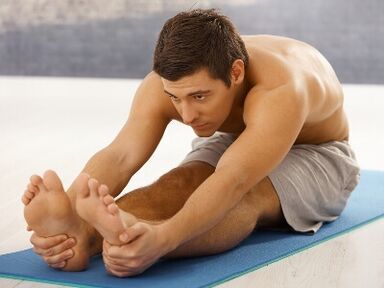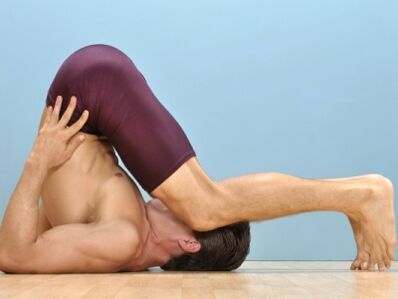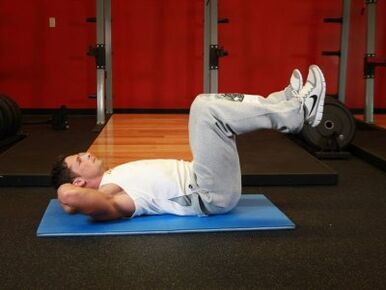
Prostatitis and benign prostatic hyperplasia are fairly common diseases in the older male population.
The main symptom of prostate adenoma is difficulty urinating due to compression of the urethra.
In these diseases, as part of a comprehensive treatment, along with drugs, folk remedies, for example, the use of dead bees for prostate adenoma and surgical methods, as well as to prevent congestion and inflammation, therapeutic exercises are recommended.
Special exercises for prostatitis and prostate adenoma should be performed long enough. They are aimed at strengthening the muscles of the pelvis, perineum, lower extremities, general strengthening of the body.
Also, recommended exercises for prostatitis and prostate adenoma are shown to a man after prostate surgery to prevent complications. In this case, they should be performed in a gentle manner and taking into account the well-being of the patient.
Physiotherapy for prostate adenoma: the main complexes of exercise

Physical therapy for prostate adenoma, as well as massage, improves blood circulation in the pelvic organs.
This can stop the development of the pathological process, reduce the growth rate of benign tumors.
Exercise for prostate adenoma includes static and dynamic exercises.
General strengthening exercises, such as walking, running, cycling, are called dynamic. It is also worth doing exercises such as squats, walking on the buttocks, rolling a ball, exercises with lifting and lifting the legs or lifting the pelvis in a supine position.
Static exercises include upright positions with prolonged tension of a particular muscle group.
It is useful to note
Strengthening the muscles of the back and abdomen is essential. Therefore, the exercises are performed in a supine position, sideways, on the abdomen, twisting and push-ups. One of the effective exercises is a wheel in a lying position, to complicate the exercise - with a raised pelvis.
Any lifting and tilting, rotational movements of the pelvis are useful. There are special sets of exercises aimed at the muscle group of the perineum.
The most famous and effective set of exercises for prostate adenoma is the Kegel complex, created by a gynecologist for women and modified for men. Its main exercises are performed in an upright and lying position, consisting of training the muscles of the anus and perineum, aimed at preventing congestion in the perineum and pelvis.
The complex should be performed in the morning, after hygienic procedures and in the evening. Exercise before bed with prostate adenoma is recommended to be performed 2-3 hours before bedtime.
Note
Exercise for prostate adenoma should be performed taking into account the well-being of the patient, should not strain and force progress, the complexity of the exercises must take into account the age of the patient and be agreed with the attending physician.
Properly selected set of exercises after prostate surgery can be of significant help in the postoperative recovery period. Exercise should be regular.
The complex of exercises itself does not take much time, but its regular use has a good effect on the general condition of the man's body and blood circulation in the pelvic organs, reduces the severity of congestion and swelling.
Also, strengthening the muscles of the abdomen and perineum has a positive effect on the process of urination and in the future will be an excellent prevention of prostate adenoma.
Important
It is also necessary to remember about moderation in performing the exercises, they should deliver pleasure and slight fatigue, but should not be accompanied by painful sensations or be done by force.
Therapeutic gymnastics for prostate adenoma

The recommended exercise for prostate adenoma is performed not only in benign prostatic hyperplasia, but may also be useful for patients who have undergone surgery for prostate cancer in chronic prostatitis.
Physical therapy in combination with drug therapy can help reduce swelling and congestion in the pelvis and, accordingly, reduce urethral obstruction and improve urine output. Therapeutic gymnastics for prostate adenoma or therapeutic exercise is performed under the supervision of a specialist, in groups, often in medical institutions and includes three stages.
In the first stage, general physical activity is given, including aerobic exercise, running, jumping and warming up.
In the second stage, special exercises are performed aimed at strengthening the muscles of the back, abdominal muscles, perineal area, those muscles that contribute to the emptying of the bladder. Various exercises are performed to reduce congestion in the pelvic organs.
In the third stage, the muscles loaded during training are stretched and relaxed.
Note
This course of exercises to achieve a stable effect should be performed regularly and take a long time. The technique of physiotherapeutic exercises must be included in the complex of therapeutic measures, including medical treatment, physiotherapy and surgery, if necessary.
Proliferation of the glandular tissue of the prostate gland is a disease associated with age, and its course strongly depends on the health and safety of the body.
Adherence to the rules of a healthy lifestyle, regular exercise, proper nutrition and diet, avoidance of bad habits have a great impact on quality of life and have a positive effect on both the onset of the disease and its course.
The habit of maintaining physical activity and using the available exercises even in old age allows you to maintain the functions of organs and systems for a long time.
























